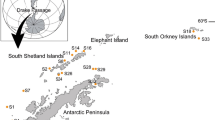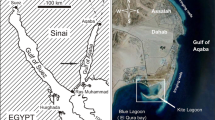Abstract
This study presents both qualitative and quantitative data regarding marine mollusk (gastropods and bivalves) shell bioerosion and encrustation based on death assemblages obtained from a recent supratidal environment in Playa Norte, Veracruz State. The objectives of this study were to assess the nature of bioerosion and encrustation processes and to investigate the role of these taphonomic features contributing to the deterioration of natural shell accumulations within a tropical siliciclastic tidal environment. The assemblage comprises 31 species: 13 gastropods and 18 bivalves. The bioerosion and encrustation degrees were low to moderate for both types. The most abundant traces were predatory gastropod structures (Oichnus paraboloides and O. simplex), whereas sponge borings (Entobia isp.), polychaete dwellings (Caulostrepsis taeniola), and echinoid raspings (Gnatichnus isp.) were less frequent. The encrusting organisms include polychaete serpulids, bryozoans, and rare foraminifers (Homotrema rubrum). Because of the low bioerosion and encrustation degrees occurring in this area, accumulation is expected to predominate over biotic destruction. As deposition conditions (richly fossiliferous carbonate sandstone beds) were similar to those prevailing in the Tuxpan Formation during the Miocene (Langhian), it is suggested that this study provides an equivalent reference to interpret mollusk fossil assemblages located in this site.



Similar content being viewed by others
References
Anderson LC, McBride RA, Taylor MJ, Birnes MR (1998) Late Holocene record of community replacement preserved in time-averaged molluscan assemblages, Louisiana chenier plain. PALAIOS 13:488–499
Armstrong-Altrin JS (2009) Provenance of sands from Cazones, Acapulco, and Bahía Kino beaches, Mexico. Rev Mex Cienc Geol 26:764–782
Armstrong-Altrin JS, Machain-Castillo ML (2016) Mineralogy, geochemistry, and radiocarbon ages of deep sea sediments from the Gulf of Mexico, Mexico. J S Am Earth Sci 71:182–200
Armstrong-Altrin JS, Lee Y, Kasper-Zubillaga JJ, Carranza-Edwards A, Garcia D, Eby GN, Balaram V, Cruz-Ortiz NL (2012) Geochemistry of beach sands along the western Gulf of Mexico, Mexico: implication for provenance. Chemie der Erde 72:345–362
Armstrong-Altrin JS, Nagarajan R, Balaram V, Natalhy-Pineda O (2015) Petrography and geochemistry of sands from the Chachalacas and Veracruz beach areas, western Gulf of Mexico, Mexico: constraints on provenance and tectonic setting. J S Am Earth Sci 64:199–216
Behrensmeyer AK, Miller JH (2012) Building links between ecology and paleontology using taphonomic studies. In: Louys J (ed) Paleontology in ecology and conservation. Springer, New York, pp 69–91
Best MMR (2008) Contrast in preservation of bivalve death assemblages in siliciclastic and carbonate tropical shelf settings. PALAIOS 23:796–809
Best MMR, Kidwell SM (2000) Bivalve taphonomy in tropical mixed siliciclasticcarbonate settings. I. Environmental variation in shell condition. Paleobiology 26:80–102
Bhattacharya B, Bhattacharya HN (2007) Implications of trace fossil assemblages from late Paleozoic Glaciomarine Talchir Formation, Raniganj Basin, India. GR 12:509–524
Bird E (2000) Coastal geomorphology: an introduction. Wiley, England, p 322
Blissett DJ, Pickerill RK (2007) Systematic ichnology of microborings from the Cenozoic White Limestone Group, Jamaica, West Indies crescent-shaped boring. Scrip Geol 134:77–108
Botello AV, Soto LA, Ponce-Vélez G, Villanueva SF (2015) Baseline for PAHs and metals in NW Gulf of Mexico related to the Deepwater Horizon oil spill. Estuar Coast Shelf Sci 156:124e133
Brett CE, Parsons-Hubbard KM, Walker SE, Fergusond C, Powell EN, Staff G, Ashton-Alcoxe KA, Raymondg A (2011) Gradients and patterns of sclerobionts on experimentally deployed bivalve shells: synopsis of bathymetric and temporal trends on a decadal time scale. Palaeo 3(312):278–304
Brett CE, Smrecak T, Parsons-Hubbard K, Walker S (2012) Marine sclerobiofacies: encrusting and endolithic communities on shells through time and space. In: Talent, JA (ed.). Earth and life. Springer, New York, pp 129–157
Bromley RG (1970) Borings as trace fossils and Entobia cretacea Portlock, as an example. In: Crimes TP, Harper, JC (ed.). Trace Fossils. Seel House Press, Liverpool, pp 49-90
Bromley RG (1975) Comparative analysis of fossil and recent echinoid bioerosion. Palaeontology 18:725–739
Bromley RG (1981) Concepts in ichnotaxonomy illustrated by small round holes in shells. Acta Geol Hisp 16:55–64
Bromley RG, D’Alessandro A (1984) The ichnogenus Entobia from the Miocene, Pliocene and Pleistocene of southern Italy. Riv Ital Paleontol Stratig 90:227–296
Butterlin J (1958) A propósito de la edad de las formaciones Escolín, Coatzintla y Tuxpan de la cuenca sedimentaria Tampico-Misantla. Bol Asoc Mex Geól Petrol 10:595–601
Cabrera R, Lugo JE (1984) Estratigrafía-sedimentología de las cuencas terciarias del Golfo de México. Bol Asoc Mex Geol Petrol 36:3–55
Carranza-Edwards A, Centeno-García E, Rosales-Hoz L, Cruz RLS (2001) Provenance of beach gray sands from western México. J S Am Earth Sci 14:291–305
Carreño A (1986) Los ostrácodos de edad Oligo-Miocenica de la Subprovincia Tampico-Misantla, área centrooriental de México. Parte II. Mioceno: Formaciones Mesón y Tuxpan. Rev Inst Geol 6:178–192
Clarke JM (1908) The beginnings of dependent life. New York State Mus Bull 121:149–169
Davis RA Jr (2011) Sea-level changes in the Gulf of Mexico. In: Davis RA Jr (ed) Sea-level changes in the early history of the Gulf of Mexico, Eberbest Printing co., China, pp 17–38
Edinger EN (2001) Bioerosion. In: DEG B, Crowther PR (eds) Paleobiology II. Blackwell, Oxford, pp 273–277
Gibert JM, Domènech R, Martinell J (2007) Bioerosion in shell beds from the Pliocene Roussillon Basin, France: implications for the (macro) bioerosion ichnofacies model. Acta Palaeontol Pol 52:783–798
Hernández U, Velez D, Ruíz H, Martínez J, Ghosh JK, Jacobo J (2004) Oligicene-Miocene sedimentation along the Western Gulf Coast: Insights from Outcrops and Subsurface Data, Onshore-Offshore Northern Veracruz, Mexico. Field Guide for AAPG International Conference and Exhibition. AAPG: 40
Holmes G, Ortiz JC, Schönberg CHL (2009) Bioerosion rates of the sponge Cliona orientalis Thiele, 1900: spatial variation over short distances. Facies 55:203–211
INAFED (2012) Cazones de Herrera http://www.inafed.gob.mx/work/enciclopedia/EMM30veracruz/municipios/30033a.html. Accessed 28 Jan 2016
Kasper-Zubillaga JJ, Dickinson WW (2001) Discriminating depositional environments of sands from modern source terranes using modal analysis. Sediment Geol 143:149–167
Kidwell SM, Best MR, Kauffman DS (2005) Taphonomic trade-offs in tropical marine death assemblages: differential time averaging, shell loss, and probable bias in siliciclastic vs. carbonate facies. Geology 33:729–732
Kowalewski M (2002) The fossil record of predation: an overview of analytical methods. In: Kowalewski M, Kelley PH (eds) The fossil record of predation. Paleontological society special papers 8, pp 3–42
Kowalewski M, Labarbera M (2004) Actualistic taphonomy: death, decay, and disintegration in contemporary settings. PALAIOS 19:423–427
Kowalewski M, Flessa KW, Hallman DP (1995) Ternary taphograms: triangular diagrams applied to taphonomic analysis. PALAIOS 10:478–483
Lara JR (2008) Los ecosistemas costeros, insulares y epicontinentales. Conocimiento actual de la biodiversidad. CONABIO, México, pp 109–134
Lescinsky HL, Edinger E, Risk MJ (2002) Mollusc shell encrustation and bioerosion rates in a modern epeiric sea: taphonomy experiments in the Java Sea, Indonesia. PALAIOS 17:171–191
Nebelsick JH, Schmid B, Stachowitsch M (1997) The encrustation of fossil and recent sea-urchin tests: ecological and taphonomic significance. Lethaia 30:271–284
Okazaki H, Stanley JD, Wright EE (2001) Tecolutla and Nautla Deltas, Veracruz, Mexico: texture to evaluate sediment entrapment on deltaic plains and bypassing onto Gulf of Mexico margin. J Coast Res 17:755–761
Parsons-Hubbard KM (2005) Molluscan taphofacies in recent carbonate reef/lagoon systems and their application to sub-fossil samples from reef cores. PALAIOS 20:175–191
PEMEX (2013) Provincia Petrolera Tampico-Misantla https://www.academia.edu/12567219/tampico_misantla Accesed 12 Feb 2018
Perrilliat C (1994) Bivalvos de la Formación Tuxpan, (Mioceno medio) Estado de Veracruz, México. Rev Mex Cienc Geol 2:232–242
Powell EN, Brett CE, Parsons-Hubbard KM, Callender WR, Staff GM, Walker SE, Raymond A, Ashton-Alcox KA (2011) The relationship of bionts and taphonomic processes in molluscan taphofacies formation on the continental shelf and slope: eight-year trends: Gulf of Mexico and Bahamas. Facies 57:15–37
Ramos-Vazquez MA, Armstrong-Altrin JS, Rosales-Hoz L, Machain-Castillo ML, Carranza-Edwards A (2017) Geochemistry of deep-sea sediments in two cores retrieved at the mouth of the Coatzacoalcos River delta, western Gulf of Mexico, Mexico. Arab J Geosci 10:148
Regan A (2017) Comparative taphonomy of molluscan death assemblages from the Gulf of Mexico. KECK Geology Consortium 30 Ann Symposium Vol: 1–7
Rosales-Hoz L, Carranza-Edwards A, Martínez-Serrano R, Alatorre MA, Armstrong-Altrin JS (2015) Textural and geochemical characteristics of marine sediments in the SW Gulf of Mexico: implications for source and seasonal change. Environ Monit Assess 187:1e19
Santos A, Mayoral E (2008) Bioerosion versus colonisation on Bivalvia: a case study from the Upper Miocene of Cacela (southeast Portugal). Geobios 41:43–59
Simoes MG (2010) Actualistic taphonomy: putting the Holocene shells to work. X Congreso Argentino de Paleontología y Bioestratigrafía y VII Congreso Latinoamericano de Paleontología http://sedici.unlp.edu.ar/handle/10915/16751 Accesed 28 Jan 2018
Spagnuolo JO, Farinati EA, Aliotta S (2013) Rodados bioerosionados en depósitos marinos holocenos del estuario de Bahía Blanca, Argentina: consideraciones paleoambientales y procedencia. Lat Am J Aquat Res 41:412–422
Stearley RF, Ekdale AA (1989) Modern marine bioerosion by macroinvertebrates, northern Gulf of California. PALAIOS 4:453–467
Tamayo JL (1991) Geografía Moderna de Mexico. Mexico, Trillas, p 400
Tapia-Fernandez HJ, Armstrong-Altrin JS, Selvaraj K (2017) Geochemistry and U-Pb geochronology of detrital zircons in the Brujas beach sands, Campeche, Southwestern Gulf of Mexico, Mexico. J S Am Earth Sci 76:246–361
Vega FJ, Feldmann R, Villalobos JL, Gío-Argaez R (1999) A new decapod fauna from the Miocene Tuxpan Formation, Eastern Mexico. J Pal 73:407–413
Vinn O, Wilson M (2010) Microconchid-dominated hardground association from the late Pridoli (Silurian) of Saaremaa, Estonia. PE 13(2):9A
Walker SE, Parsons-Hubbard K, Powell EN, Brett CE (1998) Bioerosion or bioaccumulation? Shelf-slope trends for epi- and endobionts on experimentally deployed gastropod shells. Hist Biol 131:61–72
Wicander R, Monroe JS (2000) Historical geology: evolution of earth and life through time. Brooks/Cole, California, pp 1–464
Acknowledgements
The authors would like to thank Dr. Martha Reguero Reza, curator of the “Dr. Antonio García-Cubas” Malacological Collection (Instituto de Ciencias del Mar y Limnología, Universidad Nacional Autónoma de México) and Dr. Manuel Palacios-Fest from Terra Nostra Earth Sciences. Brenda Martínez performed image editing and elaborated the location map. The first author was a holder of the postdoctoral fellowship granted by Dirección General de Apoyo al Personal Académico, Universidad Nacional Autónoma de México.
Author information
Authors and Affiliations
Corresponding author
Electronic supplementary material
ESM 1
(XLSX 94 kb)
Rights and permissions
About this article
Cite this article
Gómez-Espinosa, C., Raúl Gío-Argáez, F., Farinati, E.A. et al. Bioerosion and encrustation rates in recent mollusk death assemblages on a supratidal siliciclastic setting, Playa Norte, Veracruz State, Mexico. Arab J Geosci 11, 188 (2018). https://doi.org/10.1007/s12517-018-3549-8
Received:
Accepted:
Published:
DOI: https://doi.org/10.1007/s12517-018-3549-8




